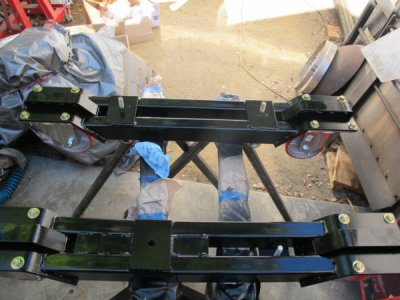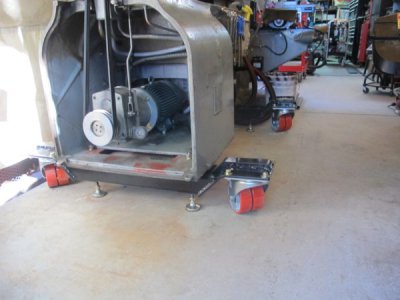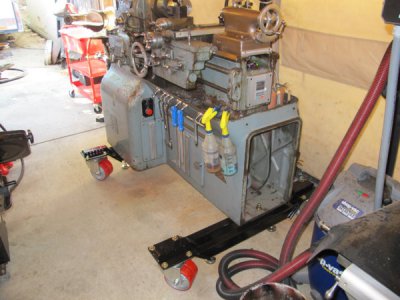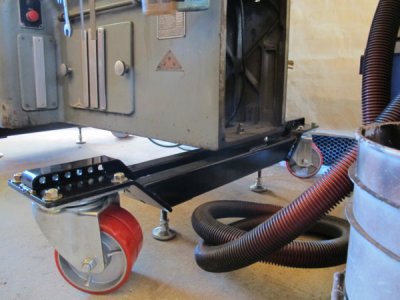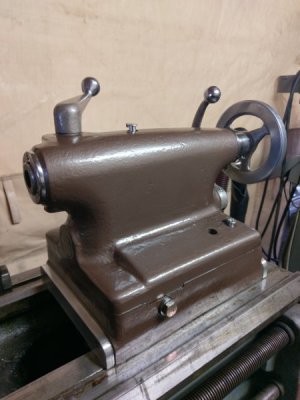Hi All,
I wasn't going to post my conversion, but my buddy talked me into it saying he thought it might help others facing the same issues.
Here's my story...
I've been wanting a 10ee for some time. Out here on the west coast they are few and far between. I haunted auctions, used equipment dealers, and, naturally CL. I finally found one pretty close that didn't appear to be completely trashed and was a reasonable price. I bought from a really nice machinist in Oakland whose shop could have been a museum of classic lathes. He bought 3 10ee's at auction keeping one and selling the other two.
I got the beast home with no issues. Many thanks to Screwy Tuesday guy Chuck B for suggesting a hydraulic drop trailer. That made the move incredibly easy.
Once home, the fun began. I have single phase 220 to the shop, so I thought about what I should do. The 10ee is a 58 Wiad, so I could have run the lathe on single phase. It had been demo'd on 3ph 440, so I knew everything worked. I read all the opinions and finally decided to pull the Wiad and go with a VFD. There are a lot of good reasons to go either way - repair and use or replace with modern electronics. What turned it for me was that after reading all the materials on the Wiad several times, I still just couldn't get a handle on it. My brain just doesn't accept the magic of electronics as real. I really wanted to want to go with the DC stuff, but, in the end, I just didn't.
First pic is the machine in its original position.
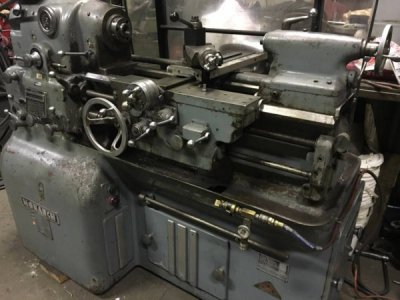
First job was removing the motor and electronics.
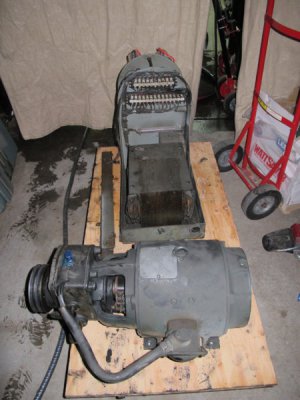
So these things are super heavy. I could barely pull the motor out onto a piece of plywood. There after I used an engine hoist to move things around. The electronics are also heavy. There's a handle that you use to pull them out of the drawer. The slides were damaged so it was no easy feat. Once I got it out of the compartment, I went to lift the assembly by the handle. Nope. Couldn't even budge it.
The motor and electronics found a good home to a guy who wanted to use them to repair his 10ee. We traded a steady rest and 4 jaw chuck for it. Really nice fella.
Next was to clean the motor compartment.
Before
: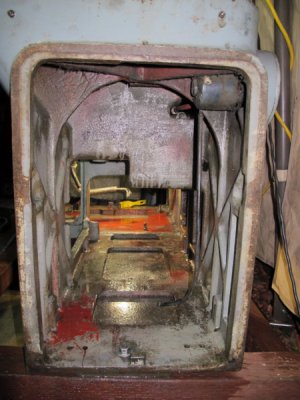
After
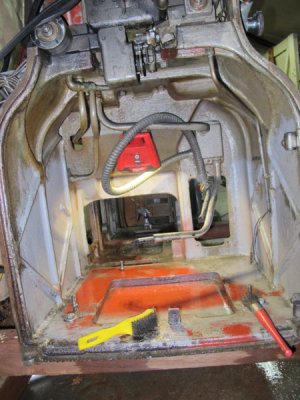
It was a dirty job, but my wife wouldn't do it.
I chose to use a 5hp with the back gear. Here's a couple of pics of the conversion
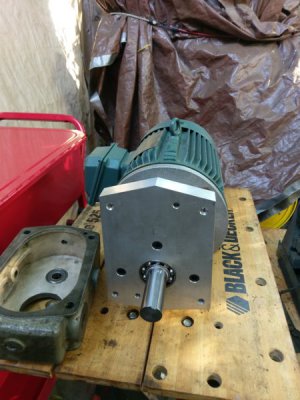
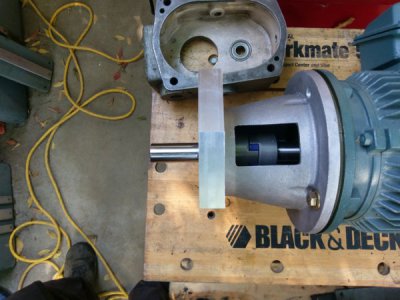
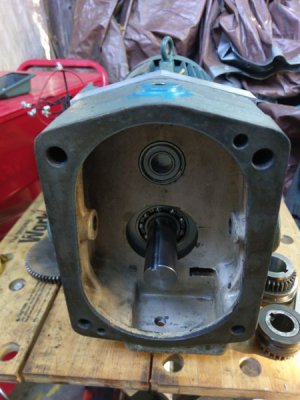
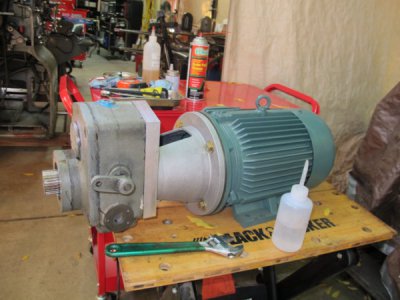
I decided to use a lovejoy connection and make the shaft adapter for the back gear. There are a pair of bearings and an oil seal on that shaft plate. I cut a key in the shaft and bored and broached the drive gear. The dogs on the shifter were worn, so I tig brazed them and then ground them to size. The key to this build, I believe, was thinking through the process and getting the order right to preserve alignment (although the lovejoy helps with any small discrepancies). I went this way because the motor required no modification, which will make a change out easier if needed in the future. I was a little nervous about boring the drive gear, but read that it was't hardened and had enough meat to take the 1 1/8 shaft with a key. Thanks to the guys who have previously shared their experiences. It's a pretty straightforward conversion, but takes some time. I think I put three long weekends into that part of the conversion.
I'm by no means a pro. I'm a hobbiest and pushing myself to learn more. My first lathe, a southbend 8k was an experience in tuning up a new machine. This was way more fun.
I mounted the motor on the original plate with spacers to clear the plate leveling screws.
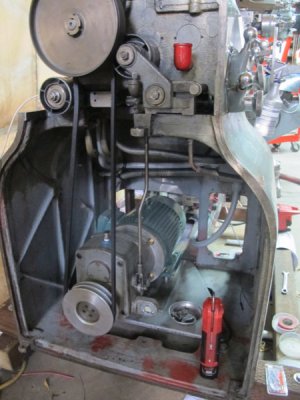
I had planned it so that the pulleys would sit 1" lower so as to accommodate standard belt sizes. That worked out just fine.
The back gear lever had enough adjustment to accommodate the 1" without further modification.
Next was the VFD. I used a Yaskawa V1000 rated for 5hp. I really thought about using one of the cheaper imports on ebay based on recommendations from many members from many different forums. In the end, I got the pricier VFD because the documentation was outstanding. I couldn't be happier with this VFD. It controls the motor quietly and the options for programming are endless. I've put in an external resistor and the stop switch will stop the motor in a fraction of a second. I put the controller in the middle compartment.
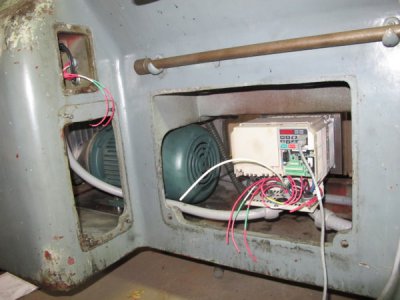
I used 16ga wire for contact switches and shielded wire for the speed control. I used the original speed control knob with a new claristat pot. It took a while to figure out how to integrate it with the VFD. For the longest time I was fussing with the programming and pulling my hair out when I realized I had the legs of the pot wired incorrectly. I put the VFD on an angled plate so I can slide it out for service. I also put everything in water tight flexible conduit. I got that all buttoned up and added an emergency stop.
I decided not to use the 3phase coolant pump. Not sure what I'll do with it. I'm not crazy about using coolant too much. Again, I'm not really doing production, so I can go light cuts and take all day. lol.
I ordered the VFD with a remote because the thought of trying to run the lathe from the main control panel seemed impractical. I decided to make use of the end of the lathe. Granted, it's not easily seen, but the keypad easily comes out of the mount so I can use it if I need to. Mostly, I run the lathe from the speed knob and RPM meter.
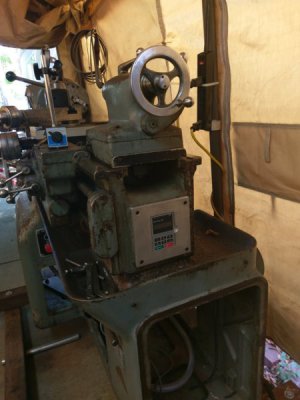
Now some of you will notice the 4x4 timbers the lathe is on. Those were attached to transport to make the whole thing more stable. When I got it home, I liked the height so much that I just left them on. I'll start a new post to show their replacement.
The conversion is not without frustration. I just kept chipping away at it until I got everything squared away. I was lucky to have a mill and lathe that were working so I could fab any part or fixture I needed. The speed control is excellent. The VFD can be programmed for constant torque, which is what I'm doing. I've taken some pretty aggressive cuts and haven't stalled the motor. The slow speed without cogging and without the back gear is about 300 rpm. With the back gear it's a fraction of that. I thought a long time about the 7.5 hp, but decided I just didn't need the power. Plus, the 5hp fits so nicely. I'd read stories about guys who had trouble getting everything inside the cabinet. I can run the lathe from the keypad, but I really like the original speed controls and switches. I did wire in the spindle lock cutout. It was a pain getting everything right, but pretty freakin' cool to be able to run the lathe as it was intended. I haven't figured out the back gear solenoid yet. I can't tell what voltage it's supposed to receive from the electrical diagrams... I think I said it was all magic. lol.
I can honestly say I'm very happy with the conversion. We'll see how it holds up over time.
Peace.
deek
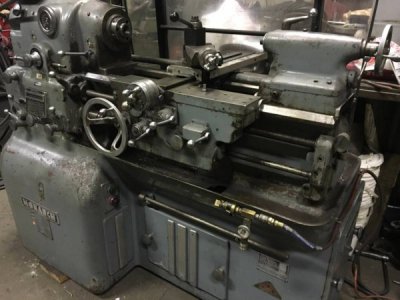
I wasn't going to post my conversion, but my buddy talked me into it saying he thought it might help others facing the same issues.
Here's my story...
I've been wanting a 10ee for some time. Out here on the west coast they are few and far between. I haunted auctions, used equipment dealers, and, naturally CL. I finally found one pretty close that didn't appear to be completely trashed and was a reasonable price. I bought from a really nice machinist in Oakland whose shop could have been a museum of classic lathes. He bought 3 10ee's at auction keeping one and selling the other two.
I got the beast home with no issues. Many thanks to Screwy Tuesday guy Chuck B for suggesting a hydraulic drop trailer. That made the move incredibly easy.
Once home, the fun began. I have single phase 220 to the shop, so I thought about what I should do. The 10ee is a 58 Wiad, so I could have run the lathe on single phase. It had been demo'd on 3ph 440, so I knew everything worked. I read all the opinions and finally decided to pull the Wiad and go with a VFD. There are a lot of good reasons to go either way - repair and use or replace with modern electronics. What turned it for me was that after reading all the materials on the Wiad several times, I still just couldn't get a handle on it. My brain just doesn't accept the magic of electronics as real. I really wanted to want to go with the DC stuff, but, in the end, I just didn't.
First pic is the machine in its original position.

First job was removing the motor and electronics.

So these things are super heavy. I could barely pull the motor out onto a piece of plywood. There after I used an engine hoist to move things around. The electronics are also heavy. There's a handle that you use to pull them out of the drawer. The slides were damaged so it was no easy feat. Once I got it out of the compartment, I went to lift the assembly by the handle. Nope. Couldn't even budge it.
The motor and electronics found a good home to a guy who wanted to use them to repair his 10ee. We traded a steady rest and 4 jaw chuck for it. Really nice fella.
Next was to clean the motor compartment.
Before
:

After

It was a dirty job, but my wife wouldn't do it.
I chose to use a 5hp with the back gear. Here's a couple of pics of the conversion




I decided to use a lovejoy connection and make the shaft adapter for the back gear. There are a pair of bearings and an oil seal on that shaft plate. I cut a key in the shaft and bored and broached the drive gear. The dogs on the shifter were worn, so I tig brazed them and then ground them to size. The key to this build, I believe, was thinking through the process and getting the order right to preserve alignment (although the lovejoy helps with any small discrepancies). I went this way because the motor required no modification, which will make a change out easier if needed in the future. I was a little nervous about boring the drive gear, but read that it was't hardened and had enough meat to take the 1 1/8 shaft with a key. Thanks to the guys who have previously shared their experiences. It's a pretty straightforward conversion, but takes some time. I think I put three long weekends into that part of the conversion.
I'm by no means a pro. I'm a hobbiest and pushing myself to learn more. My first lathe, a southbend 8k was an experience in tuning up a new machine. This was way more fun.
I mounted the motor on the original plate with spacers to clear the plate leveling screws.

I had planned it so that the pulleys would sit 1" lower so as to accommodate standard belt sizes. That worked out just fine.
The back gear lever had enough adjustment to accommodate the 1" without further modification.
Next was the VFD. I used a Yaskawa V1000 rated for 5hp. I really thought about using one of the cheaper imports on ebay based on recommendations from many members from many different forums. In the end, I got the pricier VFD because the documentation was outstanding. I couldn't be happier with this VFD. It controls the motor quietly and the options for programming are endless. I've put in an external resistor and the stop switch will stop the motor in a fraction of a second. I put the controller in the middle compartment.

I used 16ga wire for contact switches and shielded wire for the speed control. I used the original speed control knob with a new claristat pot. It took a while to figure out how to integrate it with the VFD. For the longest time I was fussing with the programming and pulling my hair out when I realized I had the legs of the pot wired incorrectly. I put the VFD on an angled plate so I can slide it out for service. I also put everything in water tight flexible conduit. I got that all buttoned up and added an emergency stop.
I decided not to use the 3phase coolant pump. Not sure what I'll do with it. I'm not crazy about using coolant too much. Again, I'm not really doing production, so I can go light cuts and take all day. lol.
I ordered the VFD with a remote because the thought of trying to run the lathe from the main control panel seemed impractical. I decided to make use of the end of the lathe. Granted, it's not easily seen, but the keypad easily comes out of the mount so I can use it if I need to. Mostly, I run the lathe from the speed knob and RPM meter.

Now some of you will notice the 4x4 timbers the lathe is on. Those were attached to transport to make the whole thing more stable. When I got it home, I liked the height so much that I just left them on. I'll start a new post to show their replacement.
The conversion is not without frustration. I just kept chipping away at it until I got everything squared away. I was lucky to have a mill and lathe that were working so I could fab any part or fixture I needed. The speed control is excellent. The VFD can be programmed for constant torque, which is what I'm doing. I've taken some pretty aggressive cuts and haven't stalled the motor. The slow speed without cogging and without the back gear is about 300 rpm. With the back gear it's a fraction of that. I thought a long time about the 7.5 hp, but decided I just didn't need the power. Plus, the 5hp fits so nicely. I'd read stories about guys who had trouble getting everything inside the cabinet. I can run the lathe from the keypad, but I really like the original speed controls and switches. I did wire in the spindle lock cutout. It was a pain getting everything right, but pretty freakin' cool to be able to run the lathe as it was intended. I haven't figured out the back gear solenoid yet. I can't tell what voltage it's supposed to receive from the electrical diagrams... I think I said it was all magic. lol.
I can honestly say I'm very happy with the conversion. We'll see how it holds up over time.
Peace.
deek


